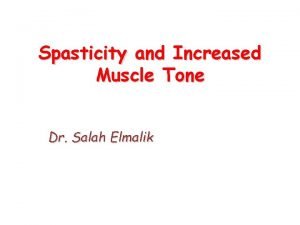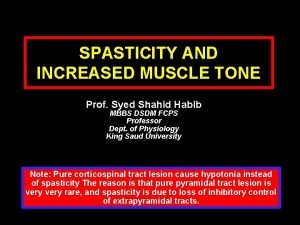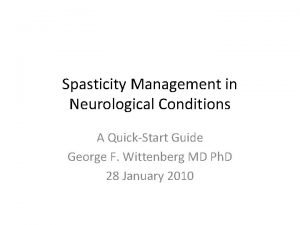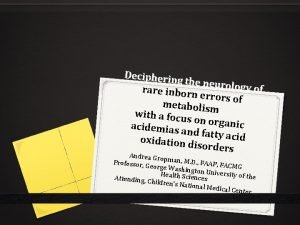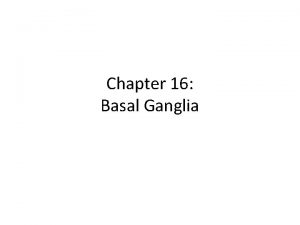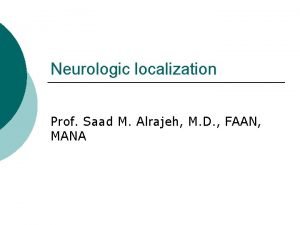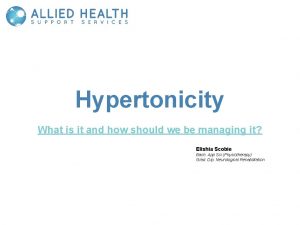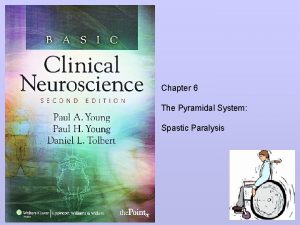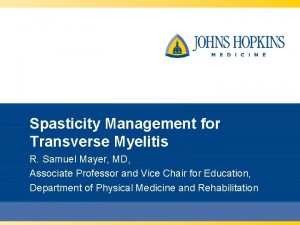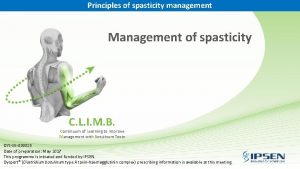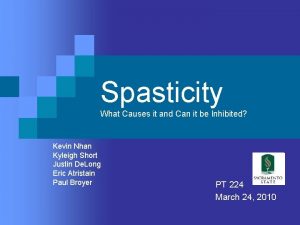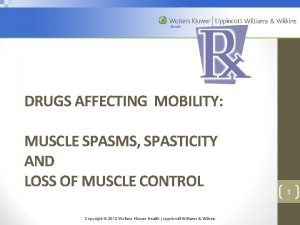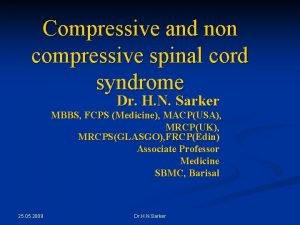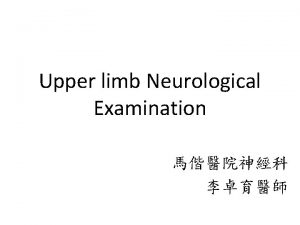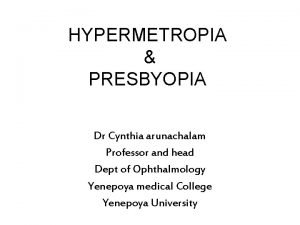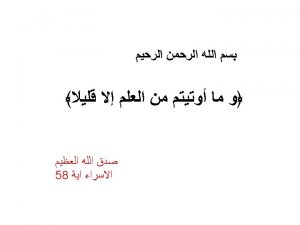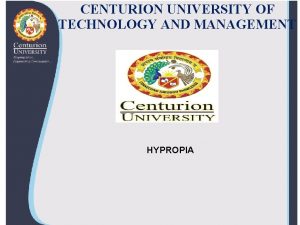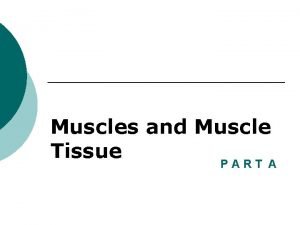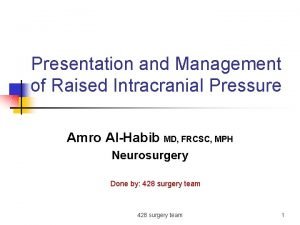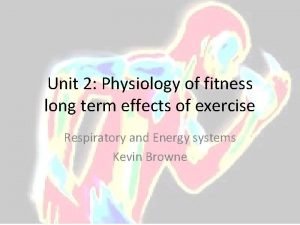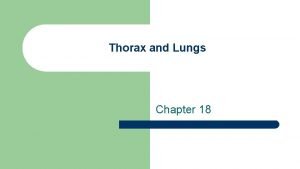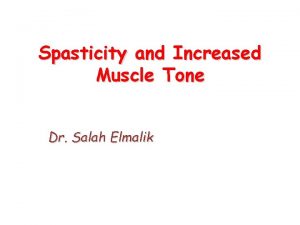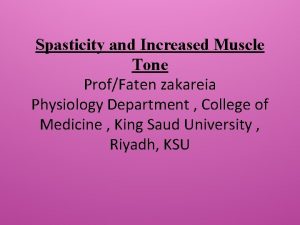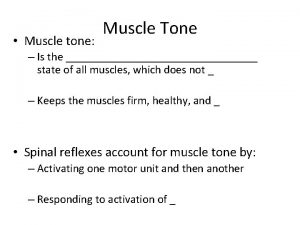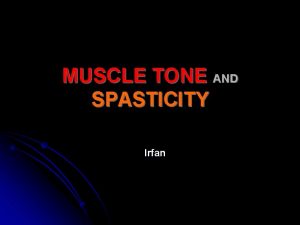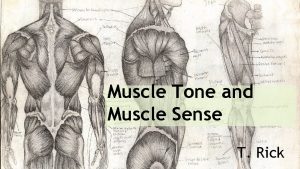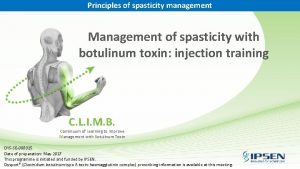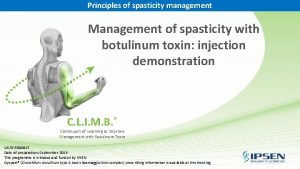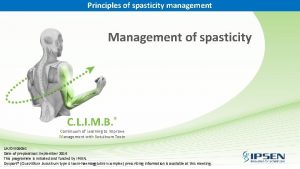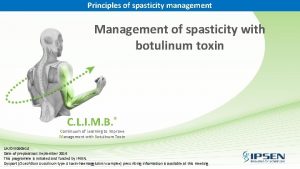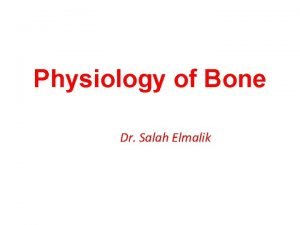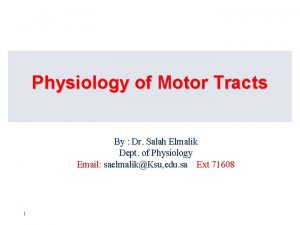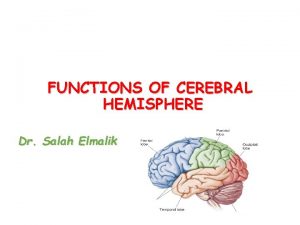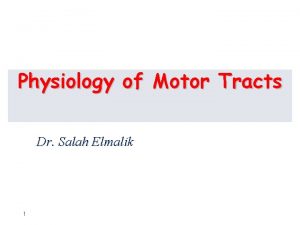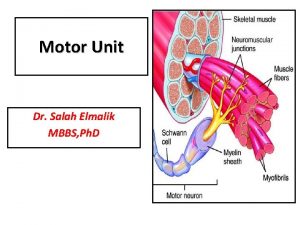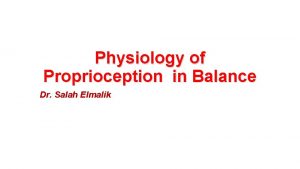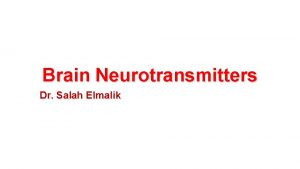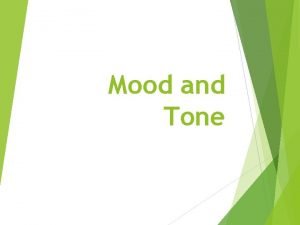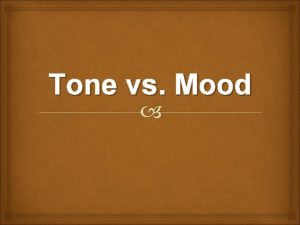Spasticity and Increased Muscle Tone Dr Salah Elmalik




























- Slides: 28

Spasticity and Increased Muscle Tone Dr. Salah Elmalik

OBJECTIVES At the end of this lecture you should be able to: q Define spasticity and rigidity. q Describe the neurophysiology of spasticity q Describe the causes of spasticity

MUSCLE TONE Resistance of a muscle to stretch is often referred to as its tone or tonus. Muscle tone is static component of stretch reflex. It is a continuous mild muscle contraction that acts as background to actual movement. A hypertonic muscle is one in which the resistance to stretch is high because of hyperactive stretch reflexes

Types of Hypertonia • Hypertonia is of two types: 1. Spasticity 2. Rigidity

Spasticity: As described by Lance (1980): “it is a motor disorder, characterised by increase in tonic stretch reflexes (muscle tone) with exaggerated tendon jerks, resulting from hyper-excitability of the dynamic stretch reflex as one component of the upper motor neurone (UMN) syndrome

§ Clinically it can be defined as increased resistance to passive stretch. 1 -Spasticity is velocity dependent increased resistance to passive movement of the muscle due to abnormally high muscle tone (hypertonia) which varies with the speed of displacement of a joint. - The faster you stretch the muscle the greater the resistance. 2 - Spasticity is clearly neural in nature and is a associated with the – UMNC 3 -Spasticity is usually uni-directional -Flexor spasticity in the upper limb & extensor spasticity in the lower limb. -Involvement of the corticospinal tract is often associated with UMNL and spasticity. There a number of clinical features that are associated with spasticity : -hyperreflexia -UMN lesions Spasticity is of Clasp Knife Type -Spasticity with the increased muscle tone together cause a contraction and deformity of a limb.

Spasticity § Spasticity is characterized by hyper- excitability of both types of stretch reflex: § 1 - increase in tonic static stretch reflexes (muscle tone) as one component of the upper motor neuron (UMN) syndrome § 2 - Exaggerated tendon jerks, resulting from hyper-excitability of the dynamic stretch reflex as one component of the upper motor neuron (UMN) syndrome

Rigidity is increased neural activity throughout the range of muscle movement and is not velocity dependent. Rigidity is present in both agonist and antagonist muscles. Rigidity is usually extra-pyramidal in origin It is often associated with basal ganglia disease such as Parkinson’s disease Rigidity in Parkinsonism: 1. Lead-pipe rigidity : Passive movement of an extremity meets with a constant dead feeling resistance like a lead pipe throughout the range of movement.

Rigidity-2 2. Cog-wheel rigidity : In cogwheel rigidity one feels that resistance varies rhythmically when applying a passive movement. It is because of an underlying resting tremor associated with rigidity.

Other types of Rigidity • Decerbrate rigidity : (extension of head & 4 limbs extensors ) • Decorticate rigidity: – (extensor rigidity in legs & moderate flexion of arms if head unturned )


Mechanism of spasticity in UMN lesions: In UMN syndrome the motor neurones are free from the descending inhibitory influence of the Higher Motor-Controlling centers ( medullary RF, red nucleus , basal ganglia)resulting in un antagonized excitatory input ( pontine RF, vestibulo-spinal) to gamma motor neurones causing hypertonia &spasticity - This results in ( 1) State of ongoing ( unremitting )contraction of muscles. ( due to hyperactive gamma activity ) (2) decreased ability to control movement (3) increased resistance felt on passive stretch.

• Causes of spasticity: A-(UMNS) syndrome include : • (1) Cerebral palsy • (2) Stroke • (3) Spinal cord injury • (4) Multiple Sclerosis • (5) Acquired brain injury ( trauma , etc ) B-Parkinsonism C-Decerebrate & decorticate rigidity

(1) Cerebral palsy Caused by brain damage due to lack of oxygen, that cause damage to the motor control centers of the developing brain , it can occur during pregnancy , during childbirth ( or after birth up to about age three by meningitis)

(2) Multiple Sclerosis Is an auto-immune demyelinating disease , in which the body's own immune system attacks and damages the myelin sheath of myelinated nerves mainly of brain , SC , and optic nerve Loss of myelin sheath (demyelination) prevents axons from saltatory conduction of action potentials causing muscle weakness& wasting. Disease onset usually occurs in young adults, and it is more common in females. The disease can attack any part of the CNS , and when it causes demyelination of descending motor tracts in the brainstem & spinal cord , the subject develops spasticity and other signs of UMNS. The disease frequently remits and relapses because of remylination & restore of function and during acute attacks intravenous corticosteroids can improve symptoms

3 - STROKE: a-Haemorrhagic stroke as in cerebral haemorrhage b- Ischaemic stroke as in thrombosis or embolism -all cause death of brain tissues, results in paralysis in the opposite half of the body. A lesion in Corona Radiata on one side can cause Monoplegia in a contralateral limb (UL or LL , according to site). A lesion in the Internal Capsule on one side may cause Hemiplegia or Hemiparesis on the contralateral side ( with the picture of upper motor neuron syndrome ).


Complete transection of spinal cord-1 Ø The higher the level of the section, the more serious are the consequences. Ø If the transection is in the upper cervical region immediate death follows, due to paralysis of all respiratory muscles. Ø In the lower cervical region below the 5 th cervical segment diaphragmatic respiration is still possible, but the patient suffers complete paralysis of all four limbs (quadriplegia). Ø Transection lower down in the thoracic region allows normal respiration but the patient ends up with paralysis of both lower limbs (paraplegia)

Complete transection of spinal cord-2 • Stages : - A/ Spinal shock ( 2 -6 weeks ) B/ Recovery of reflex activity C/ Paraplegia in extension A/ Spinal shock In the immediate period following transection there is : (1) complete loss of spinal reflex activity below the level of the lesion. (2) Loss of all sensations (anaesthesia) and voluntary movement ( paralysis) below the level of the lesion , due to interruption of all sensory and motor tracts (3) Loss of tendon reflexes and superficial reflexes (abdominal , plantar & withdrawal reflexes ). (4) The loss of muscle tone (flaccidity) and absence of any muscle activity (muscle pump ) lead to decreased venous return causing the lower limbs to become cold and blue in cold weather

Complete transection of spinal cord-3 (5)The wall of the urinary bladder becomes paralysed and urine is retained until the pressure in the bladder overcomes the resistance offered by the tone of the sphincters and dribbling occurs. This is known as retention with overflow. (7)Loss of vasomotor tone occurs, due to interruption of fibers that connect the vasomotor centres in the medulla oblongata with the lateral horn cells of the spinal cord, which project sympathetic vasoconstrictor impulses to blood vessels. vasodilatation causes a fall in blood pressure; the higher the level of the section, the lower the blood pressure. (8) Bedsores due to pressure of body-weight against underlining support -This stage varies in duration but usually lasts a maximum of 2 -6 weeks, after which some reflex activity recovers.

B/ Stage of return of reflex activity As the spinal shock ends , spinal reflex activity appears again this partial recovery may be due to : . -sprouting of fibres from remaining neurons -denervation hyper sensitivity to excitatory neurotransmitters Features of the stage of recovery of reflex activity: (1) Gradual rise of arterial blood pressure due to return of spinal vasomotor activity in the lateral horn cells. But, since vasomotor control from the medulla is absent, the blood pressure is not stable

(2) Return of spinal reflexes ü Flexor reflexes return earlier than extensor ones. ü However postive Babiniski sign ( extensor plantar reflex) is one of the earliest signs of this stage. -Tendon reflexes also recover earlier in flexors. - As a result, flexor spastic tone causes the lower limbs to take a position of slight flexion, a state referred to as paraplegia in flexion. -The return of the stretch reflex ( & consequently muscle tone) , and vasoconstrictor tone in arterioles and venules , improve the circulation through the limbs ü (3) Recovery of visceral reflexes: return of micturition, defecation & erection reflexes. -However , voluntary control over micturition and defecation , and the sensation of bladder and rectal fullness are permanently lost. (4) Sexual reflexes, reflexes consisting of erection or ejaculation on genital manipulation , recover.

(5) Mass reflex appears in this stage - A minor painful stimulus to the skin of the lower limbs will not only cause withdrawal of that limb but will evoke many other reflexes through spread of excitation (by irradiation) to many autonomic centers. So the bladder and rectum will also empty, the skin will sweat, the blood pressure will rise Since effective regeneration never occurs in the human central nervous system, patients with complete transection never recover fully. Voluntary movements and sensations are permanently lost. however, patients who are rehabilitated and properly managed may enter into a more advanced stage of recovery.

C/ Stage of extensor paraplegia (1) During this stage the tone in extensor muscles returns gradually to exceed that in the flexors. The lower limbs become spastically extended. Extensor reflexes become exaggerated, as shown by tendon jerks and by the appearance of clonus. The positive supportive reaction becomes well developed and the patient can stand on his feet with appropriate support. (2) The flexor withdrawal reflex which appeared in the earlier stage is associated during this stage with the crossed extensor reflex.

Hemisection of the Spinal Cord ( Brown-Sequard syndrome)

Hemisection of the Spinal Cord ( Brown-Sequard syndrome) A/ At the level of the lesion: all manifestations occur on the same side: 1. Paralysis of the lower motor neuron type 2. Loss of all sensations in the areas supplied by the afferent fibers that enter the spinal cord in the damaged segments 3. Vasodilatation of the blood vessels that receive vasoconstrictor fibers from the damaged segment B/ Ipsilaterally below the level of the lesion : 1. Paralysis of UMN type due to interruption of pyramidal and extrapyramidal tracts. 2. Fine touch, position and vibration sense are lost 3. Vasodilatation C/ Contralaterally below the level of the lesion : • Pain and temperature sensations are lost, Why ?


THANK YOU
 Tone vs spasticity
Tone vs spasticity Rigidity vs spasticity
Rigidity vs spasticity Ashworth tone scale
Ashworth tone scale Clasp knife spasticity
Clasp knife spasticity Hypertonia vs spasticity
Hypertonia vs spasticity Lentiform
Lentiform Hemianopasia
Hemianopasia Tardieu skala
Tardieu skala Pyramidal system
Pyramidal system Spasticity
Spasticity Spasticity
Spasticity Spasticity
Spasticity Spasticity
Spasticity Non compressive myelopathy
Non compressive myelopathy Falling intonation examples
Falling intonation examples Fusiform fibers smooth muscle
Fusiform fibers smooth muscle Toe dancers muscle a two bellied muscle of the calf
Toe dancers muscle a two bellied muscle of the calf Power examination
Power examination Manual motor testing
Manual motor testing Latent hyperopia
Latent hyperopia What is the stretch reflex
What is the stretch reflex Facultative hypermetropia
Facultative hypermetropia Skeletal muscke
Skeletal muscke Formal and informal conversation pdf
Formal and informal conversation pdf Informal writing examples
Informal writing examples Signs and symptoms of increased icp
Signs and symptoms of increased icp Increased aerobic and anaerobic enzymes
Increased aerobic and anaerobic enzymes Chapter 6 training for fitness
Chapter 6 training for fitness Increased tactile fremitus occurs with
Increased tactile fremitus occurs with
